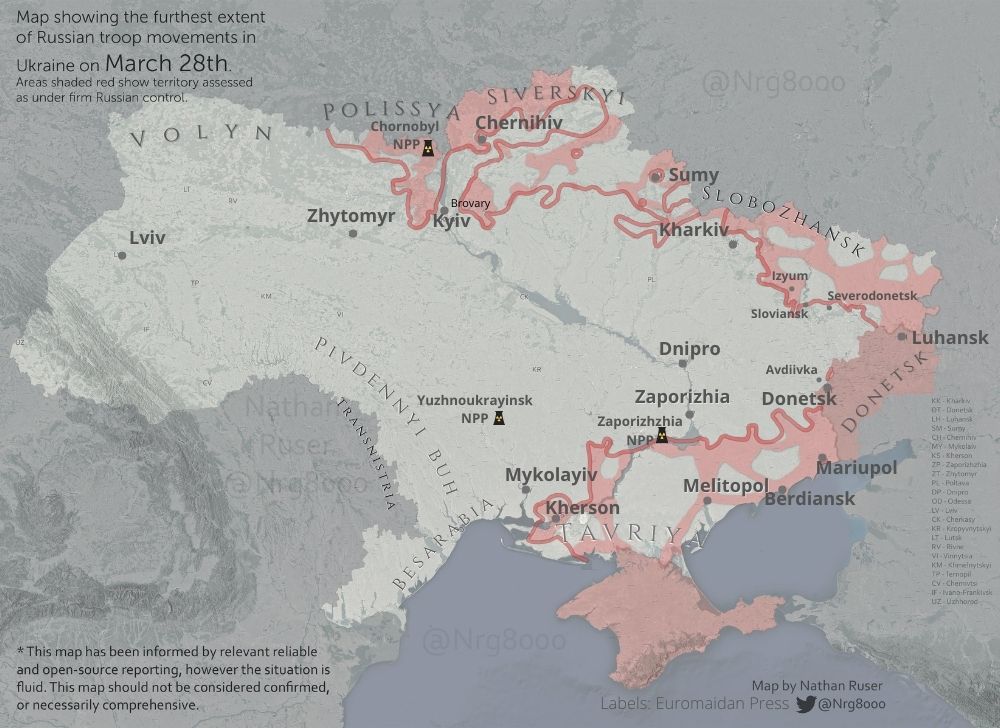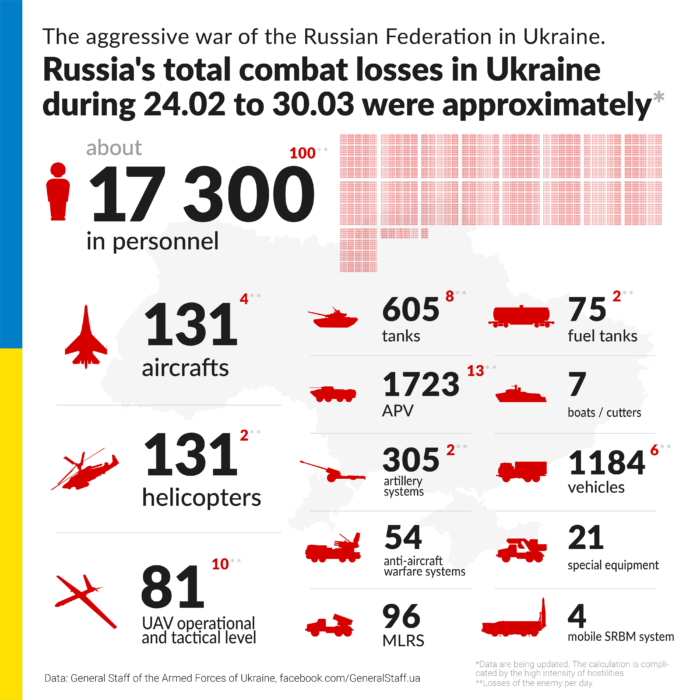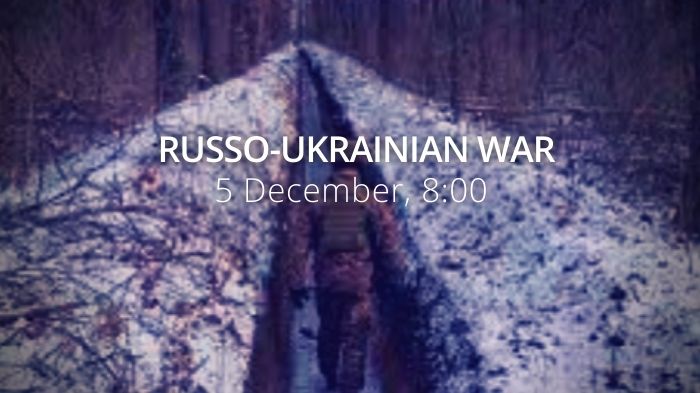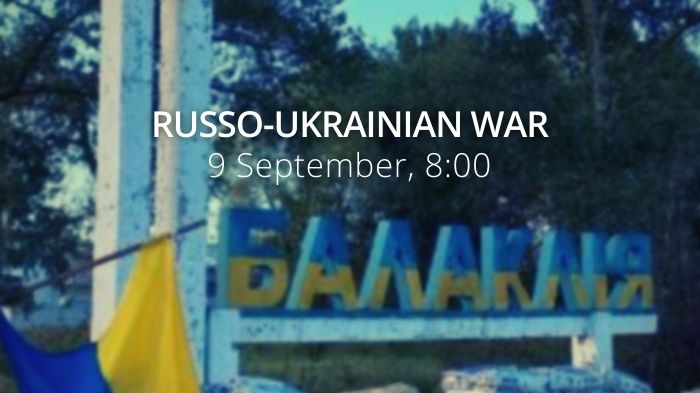Morning report day 35 – March 30
The report is based on media reports, expert analyses, and official information posted online.
Situation
According to information from the General Staff as of 06.00 30.03.2022, supplemented by its [midnight assessment]:

[The tasks of reaching the administrative borders of Donetsk and Luhansk oblasts, encircling the city of Kyiv and establishing control over the left-bank part of Ukraine remain unfulfilled by the enemy.]
[Withdrawal of units of the Armed Forces of the Russian Federation from the territory of Kyiv and Chernihiv oblasts continues.]
[According to some indications, the Russian forces are regrouping units to focus their main efforts on the East. At the same time, the so-called “withdrawal of troops” is probably a rotation of individual units and aims to mislead the military leadership of the Armed Forces of Ukraine and create a misconception about the occupiers’ refusal to plan to encircle the city of Kyiv.]
[There are no significant changes in the composition and position of the Russian enemy’s troops in the Volyn, Polissya, and Siversky areas. The Russian forces are trying to keep the previously occupied borders, they are not carrying out active offensive operations in these areas.]
[In the direction of Sloviansk, the enemy continues to hold positions in the area of the settlements of Kamyanka, Sukha Kamyanka, and implement measures to supply Russian troops, regroup units and replenish supplies continued.]
[In the Donetsk direction, the enemy continues to fire and storm. It carried out air and missile strikes in the areas of Kreminna and Mariupol. Its main efforts were focused on taking control of the settlements of Popasna, Rubizhne, as well as the complete capture of Mariupol, which was not successful.]
[No changes in the composition and position of the enemy were recorded in the Tavriya direction.]
- [The Russian forces carried out artillery shelling of the positions of the units of the Defense Forces of Ukraine near the settlements of Stepnohirsk, Orikhove, and Huliaipole.]
- [In the areas of Novokarlivka and Luhivske settlements, the Russian forces continues to carry out fortification equipment of occupied positions and install minefields.]
[In the Pivdennyi Buh directions, the Russian forces are taking measures to restore the combat capability of its units. It does artillery fire and airstrikes, trying to restrain the actions of units of the Armed Forces of Ukraine.]
[There are no significant changes in the Black Sea and Azov operational zones.]
In the past 24hrs, the Joint Forces of Ukraine have repulsed four attacks by the Russian occupiers in the Donetsk and Luhansk areas. Our soldiers destroyed 7 tanks, 7 armored vehicles units, 2 vehicles, and an anti-tank gun. The enemy suffered casualties.“
During the last 24 hours, the Ukrainian General Staff has reported on the Russian manning and logistic challenges:
- The enemy is weakened, disoriented, much of it is cut off from logistics and continues to suffer losses.
- Units of the 4th (Tskhinvali district, South Ossetia) and 7th (Abkhazia) military bases, which are part of the Southern Military District of the Armed Forces of the Russian Federation, were transferred from the occupied territories of Georgia to the territory of Ukraine in order to recruit the armed forces of the Russian federation.
- From the 4th military base, three Batallion Task Groups (BTGs) with a total number of up to 1,200 Russian and Ossetian servicemen were formed and sent to Ukraine. Two units of the 7th Military Base were formed, which is about 800 people.
- In the temporarily occupied territory of the Luhansk Oblast, the occupying authorities plan to hold another wave of mobilization from April 1 this year. Such efforts may be made in the recently occupied territories of the region.
- According to available information, the armed forces of the Russian Federation continue to have problems with manning units. Thus, servicemen of the 26th Tank Regiment of the 47th Tank Division, who signed contracts after they started participating in the war with Ukraine, have begun to submit reports requesting to terminate the contract and send them to a permanent location for further service.
- [There is a problem with strengthening and rotating the existing Russian forces. Thus, only in the Pacific Fleet, recruitment units, due to the refusal of personnel to participate in the so-called “special operation”, are not able to staff even one battalion-tactical group.]
- On the territory of the Russian Federation, in the area of the settlement of Boguchar, the Russian enemy is taking measures to remove from long-term storage of military and special equipment. More than 40% of this equipment is out of order.
In addition to capturing and destroying civilian ships and attacking Ukraine from the sea, Russia has also been laying sea mines in the Black Sea since 24 February. The Ministry of Foreign Affairs of Ukraine highlights in a statement that the mines that were discovered on March 26-28, 2022 off the coast of Türkiye and Romania are not registered with the Naval Forces of the Armed Forces of Ukraine:
“These mines were seized by the Russian armed forces in 2014 during the military invasion and temporary Russian occupation of the Ukrainian city of Sevastopol. Thus, Russia, using naval mines seized in 2014, deliberately provokes and discredits Ukraine in front of international partners.”
A major Ukrainian internet provider reports a cyberattack on Monday, The New York Times reports. Ukrtelecom, Ukraine’s second-biggest telephone and internet company, suffered a large cyber attack, the State Special Communications Service of Ukraine reported. The agency said Russian forces were responsible. The provider reduced service to most private users and business clients during the attack to be able to continue providing it to Ukraine’s military. NetBlocks, an independent global internet monitor, reported it was the most serious attack on the provider since Russia invaded Ukraine last month, reducing Ukrtelecom connectivity to only 13 percent of prewar levels.
According to British Defence Intelligence, (last 24 hours):
- Russian units suffering heavy losses have been forced to return to Belarus and Russia to reorganize and resupply. Such activity is placing further pressure on Russia’s already strained logistics and demonstrates the difficulties Russia is having reorganizing its units in forwarding areas within Ukraine.
- Russia will likely continue to compensate for its reduced ground maneuver capability through mass artillery and missile strikes.
- Russia’s stated focus on an offensive in Donetsk and Luhansk is likely a tacit admission that it is struggling to sustain more than one significant axis of advance.
- Repeated Russian setbacks and successful counterattacks by Ukrainian forces mean it is almost certain that the Russian offensive has failed in its objective to encircle Kyiv.
- Russian statements regarding a reduction in activity around Kyiv, and reporting indicating the withdrawal of some Russian units from these areas, may indicate Russia’s acceptance that it has now lost the initiative in the region.
- It is highly likely that Russia will seek to divert combat power from the north to their offensive in the Donetsk and Luhansk regions in the east.
As of Wednesday 30.03.2022, the approximate losses of weapons and military equipment of the Russian Armed Forces from the beginning of the war to the present day:

- personnel – more than 17,300 people (+100),
- tanks – 605 units (+8),
- armored combat vehicles – 1723 units (+13),
- artillery systems – 305 (+2),
- multiple rocket launchers – 96 (no change)
- air defense means – 54 (no change),
- aircraft – 131 (+4),
- helicopters – 129 (+2),
- automotive technology – 1184 (+6),
- vessels/boats – 7 units (no change),
- fuel and lubricant tanks – 75 (+2),
- UAV operational and tactical level – 81 (+10)
- Special equipment – 21 (no change)
- Mobile SRBM system – 4 (no change)
Humanitarian
According to UNHCR 3,901,713 refugees has been registered as of 28 March 12 CET. The UN says that so far Poland has taken in 2,314,623 refugees, Romania 602,461, the Republic of Moldova 385,222, Hungary 359,197, Slovakia 278,238, Russian Federation 271,254 (no changes since recent evaluation), and Belarus 9,875.
Environmental
The head of the International Atomic Energy Agency arrived in Ukraine on Tuesday for talks with government officials over the safety of the country’s nuclear facilities, which have been targeted by Russian forces, The New York Times reports. The I.A.E.A said the visit would lay the groundwork for sending its experts into the country to help protect Ukraine’s nuclear sites amid the Russian invasion.
“The military conflict is putting Ukraine’s nuclear power plants and other facilities with radioactive material in unprecedented danger,” Mr Grossi said in a statement. “We must take urgent action to make sure that they can continue to operate safely and securely and reduce the risk of a nuclear accident that could have a severe health and environmental impact both in Ukraine and beyond.”
The General Staff of Ukraine claims that:
- The Russian Federation and its numerous agencies in international organizations deny the transportation and accumulation of large quantities of ammunition by Russian troops near the Chernobyl Shelter. The activities of the Russian occupation forces at any time could lead to the detonation of ammunition, damage to the Chernobyl Shelter and radiation contamination of the territory where hundreds of millions of Europeans live.
- We emphasize that, as in most other cases, the Russian Federation and its agents of influence are spreading misinformation. The use of the Chernobyl zone for the transportation and accumulation of ammunition, as well as the deployment of command posts of Russian troops, is carried out deliberately, as the Armed Forces of Ukraine cannot conduct hostilities in the exclusion zone. The risk of detonation of Russian ammunition is high and without hostilities, due to the Russian occupiers’ neglect of security measures, as well as the widespread use of old and substandard ammunition. Such incidents occur in Russian warehouses and arsenals regularly and in peacetime, which is well known.
Legal
War crimes against Ukrainian children
Inna Zavorotko, Major, Armed Forces of Ukraine, Department of International and European Law, National University of “Kyiv-Mohyla Academy” reminded the world about our universal commitment to protect children during conflict:
“As per the morning of 28 March 2022, Russian attacks on Ukraine have killed at least 143 innocent children and injured more than 216 since 24 February 2022, the General Prosecutor’s Office of Ukraine and the Ukrainian Parliament Commissioner for Human Rights stated. 143 names protected by international law were killed by Russian immorality.
During international armed conflict (that is caused by Russian aggression and going on between Russia and Ukraine) children are protected by different branches of international law.
Firstly, international humanitarian law protects children generally (as taking no part in hostilities persons) and especially (as particularly vulnerable persons). ... Besides this, during the international armed conflict children are considered a vulnerable group and object of special respect and protection against any form of indecent assault, (Article 77 of Protocol Additional to the Geneva Conventions of 12 August 1949, and relating to the Protection of Victims of International Armed Conflicts (Protocol I)).
Secondly, international law of human rights and international treaties require to respect rights of children during armed conflicts and taking all feasible measures to ensure the protection and care of children. Moreover, all appropriate measures to promote physical and psychological recovery and social reintegration of a child victim of the crime or armed conflict must be taken (Articles 38, 39 of The United Nations Convention on the rights of the child). Optional Protocol on the Involvement of Children in Armed Conflict (2000) and Declaration on the Protection of Women and Children in Emergency and Armed Conflict (1974) also address different aspects of children’s rights during the international armed conflict.
Lastly, “soft law,” especially within UN Security Council Resolutions, widely addresses children’s protection during armed conflicts. One of the most influential of them is UN Security Council Resolution 1261 (1999). It defines six serious violations against children during the armed conflict. They are annually analyzed in the Report of the Secretary-General “Children and armed conflict” and Report of the Special Representative of the Secretary-General for Children and Armed Conflict. Among mentioned six violations against children are
- recruitment and use of children,
- killing and maiming of children,
- rape and other forms of sexual violence against children,
- attacks on schools, hospitals and protected persons concerning schools and/or hospitals,
- abduction of children and
- denial of humanitarian access.
As of 28 Mar 2022, there are sufficient grounds to believe that at least 3 of mentioned above 6 violations are committed by the Russian Armed Forces against Ukrainian children: killing and maiming of children, attacks on schools, hospitals and protected persons concerning schools and/or hospitals and denial of humanitarian access.
All mentioned violations against Ukrainian children are war crimes, defined by Article 8 of the Rome Statute. There is no forgiveness for Russian war criminals. Only criminal punishment and moral coercion.”
The Ukrainian General Staff claim that Russian forces continue to commit illegal acts against the local population.
- Thus, in the settlement of Velyka Bilozirka, units of the Russian occupiers were scattered throughout the settlement and placed equipment between residential buildings.
- In the city of Melitopol, the Russian invaders on the outskirts of the city equipped checkpoints and strengthened the bypass regime.
- The Russian forces continue to loot the homes and apartments of local residents, detain pro-Ukrainian activists and government officials in Ukraine.
DIU has published the list of names of military personnel of the 54th Training Center (military unit 90091)for intelligence units involved in the commission of war crimes against the people of Ukraine on its websites.
Russian invaders continue to kidnap pro-Ukrainian activists: on 29 March, it was reported that the pro-Ukrainian mayor of Primorsk went missing after trading himself in for his kidnapped father.
https://twitter.com/EuromaidanPress/status/1508906196505403397
Support
Due to sanctions, the implementation of Russian defense orders are disrupted, the Defence Intelligence of Ukraine (DIU) reports on 29 March. Some defense order contracts are on the verge of failure due. Russian defence enterprises report problems continuing production due to rising prices for raw materials and components.
“In recent decades, military production and “rearmament” of the Russian army has become possible through the mass purchase of foreign technology, materials and electronics. Without this opportunity to continue the production of modern weapons (missiles, tanks, aircraft) has become virtually impossible. Today, the KAMAZ plant has become a striking example of ‘technological independence’ and ‘import substitution’ of the Russian Federation. Modern models produced by the plant were equipped with Cummins engines (USA), ZF transmission (Germany) and Bosch fuel equipment (Germany). Now they have been forced to return to the production of models of the 1960s, which the Russians called ‘classic‘.”
New developments
- Ukraine presented a 10-point plan under the negotiations in Istanbul on 29 March. According to the head of the Russian delegation Vladimir Medinsky, Kyiv’s proposals will be studied in the near future and reported to the president, and then Moscow will come back with a response, TASS reports.
- The Russian-Ukrainian talks that took place in Istanbul on Tuesday were constructive, the head of the Russian delegation, Presidential Aide Vladimir Medinsky, TASS reports. He said Moscow made two de-escalatory steps. One was offering to hold a meeting between presidents Vladimir Putin and Vladimir Zelensky simultaneously with the initialling of a peace treaty by their Foreign Ministries, or earlier than planned before. In the other step, Russian troops would drastically reduce their activities toward Kyiv and Chernihiv. The talks were supposed to last two days – March 29 and 30 – but sources in the Russian delegation and the Turkish Foreign Ministry said the round was over and the meeting on Wednesday was off.
- Russia Vows to Reduce Attacks in Northern Ukraine, The New York Times reported Tuesday. Russia said a meeting between President Putin and President Zelensky could be held once a draft peace agreement was ready. Ukrainian officials for the first time outlined potential concessions on territory occupied by Russia, proposing to negotiate the status of Crimea over 15 years. The future of the eastern areas that Russia no longer recognizes as part of Ukraine could be discussed between President Putin and President Zelensky, an aide to Zelensky said on Tuesday. However, during the night of 29/30 March, the Russian army maintained its attacks on Kyiv and Chernihiv oblasts, Chernihiv Regional Head Chaus and MIA advisor Denysenko reported. Irpin, Chernihiv, and Nizhyn are reported to have been shelled the entire night, and Russian missiles were shot down above Kyiv.
https://twitter.com/EuromaidanPress/status/1509122910992183298 - The Verkhovna Rada will consider a bill proposing to ban the activities of the Ukraine Orthodox Church under the Moscow Patriarchate (UOC-MP) on the territory of Ukraine, Ukrainska Pravda reports. The bill proposes to transfer the ownership of its properties. All property should be nationalized. ME: UOC-MP is a part of the Russian Orthodox Church and a tool to expand the Russian World. Russian foreign policy and ROC are closely linked. The bill will, therefore, be unacceptable to Russia.
Assessment
On the War
The Institute for the Study of War has made the following assessment as of Tuesday 29 March:
Russia continues to reinforce its efforts in Ukraine’s northeast likely attempting to link its positions southeast of Kharkiv and Izium with its forces in Luhansk Oblast. The Russians have reportedly redirected forces from the Chernihiv-Kharkiv axis to the Izium-Sloviansk axis, most likely reassigning reinforcements rather than redeploying units already committed to fighting. Russian forces in the Izium-Sloviansk area continue fighting to hold and expand their penetration to the southeast.
The Russian advance in Mariupol continues to gain ground, and Russian forces have likely bisected or even trisected the city. Pockets of Ukrainian defenders continue to hold out in Mariupol, likely in several areas, but the Russians will likely complete the conquest of the city within days. Russian forces have likely taken significant casualties in the tough urban fighting in Mariupol, making it difficult to evaluate how much combat power the Russians will be able to harvest from Mariupol to use for further advances north and west.
Russian operations in southeastern Ukraine have left large portions of Donetsk Oblast under Ukrainian control. Securing the boundaries of Donetsk Oblast along with the entirety of Luhansk Oblast will likely require a major offensive operation. Much of the area of Donetsk Oblast outside Russian control is flat and sparsely populated—terrain similar to that on which Russian forces elsewhere have been able to advance rapidly, at least earlier in the war. Russian offensive operations in similar terrain more recently have struggled, however. It is too soon to tell how feasible the Russian conquest of all of Donetsk and Luhansk will be for the Russian military in its current state.
Key Takeaways
- We now assess that Russian forces have given up on encircling or seizing Kyiv at this time. Russian forces continue to fight to hold their current front-line trace near the city, however, remaining dug into positions to the east, northwest, and west. Russian forces withdrawing from the area around Kyiv appear to be moving north from behind the front line to positions in Belarus.
- Russia is directing some reserves to the effort to connect gains southeast of Kharkiv and Izium with its front line in Luhansk.
- Ukrainian forces continue to defend in likely isolated pockets in Mariupol. The city will likely fall to the Russians within days.
- A Russian offensive operation to take the rest of the unoccupied Donetsk Oblast would be a significant undertaking. It remains unclear if Russia can harvest enough combat power from Mariupol after securing the city or divert reinforcements from elsewhere on a large enough scale to complete it.”
Read more about Ukraine’s proposed “peace plan” here: How realistic is the Ukrainian “peace plan”?








